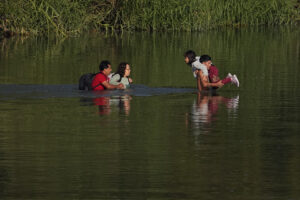Women in the Middle East: Past and Present
Read the entire introduction to UCLA professor emerita Nikki Keddie's new book, "Women in the Middle East: Past and Present."
Editor’s note: The following is the introduction to “Women in the Middle East: Past and Present” (Princeton University Press, 2006) by UCLA professor emerita Nikkie Keddie.
The book can be purchased here.
The study of Middle Eastern women, past and present, has developed so rapidly in the past few decades that periodic overviews of the topic are needed to present syntheses of what is currently known and indicate the bases of that knowledge. This book tries to meet some of those needs and features a book-length history of Middle Eastern women. It also includes several essays that elucidate the current state of writing on these women, suggest what is needed to further their study, and analyze what has been accomplished in this field and what remains to be done. In a field of study that is quite new and developing rapidly, it is useful to bring together a summary, based on current knowledge, of the lives, problems, and accomplishments of Middle Eastern women as they have evolved to the present, one that also suggests what approaches might best be utilized to guide future research and writing.
In writing the book-length history, I was struck both by the excellence of many of the monographs and surveys on the subject, and by the difficulty of trying to bring together their results, along with the results of my own primary research and experience, into a narrative history. Middle Eastern women’s history has been pursued seriously for only about thirty years, and most of the existing work necessarily deals with limited subjects, so that there are major gaps when one is trying to put together a comprehensive narrative. Also, there are areas for which there appears thus far to be little primary evidence, and areas where authors are very influenced by intellectual or ideological commitments of different kinds. Nonetheless, it appeared worthwhile to try to construct a narrative reflecting what is known today, based largely on the past thirty years of extensive scholarly work in many disciplines, which may be useful for students, scholars, and a broader public.
Apart from the book-length history, the volume includes a selected group of my articles, comprising those that I considered most relevant to the study and analysis of Middle Eastern women. I have not included all the articles and introductions I have authored or coauthored regarding Middle Eastern women, but only those that seemed of most general interest and most relevant to the current book. At the suggestion of my Princeton University Press editor I have retitled some articles to clarify their place in this book, but give the original titles in full references. The region defined as the Middle East in this book goes from Morocco in the West to Afghanistan in the East, comprising lands in which the predominant languages are Arabic, Persian, Turkish, and Pushtu, although not all regions are equally covered in all essays. I do not attempt to cover central Asia to the north or African countries to the south of Morocco or Egypt except when they constitute parts of larger Middle Eastern empires.
Book One consists of the book-length “Women in the Middle East: A History,” which utilizes many studies about women past and present that have appeared in recent decades to synthesize an analytic history of the subject from pre-Islamic times to the present. Among its special features is individual coverage of women in most of the many Middle Eastern countries that have come into existence since 1945, most of which have not been the subject of individual narrative historical books or articles. Such individual coverage, however problematic some of the sources still are, is needed, as individual governments differ in laws, in educational, health, and labor policies, and in many cultural and political characteristics. This history also tries to incorporate the best-documented conclusions that result from the many recent studies on a variety of relevant subjects, including analyses of views regarding women in the early Islamic period, assessments of the role of Turks and Mongols, analyses of Ottoman court records, studies of women’s rights movements, and works that analyze both favorable factors and obstacles to women’s achievement of equality. It also recognizes the scarcity of sources for many periods or questions, and discusses some of the different interpretations of the same materials. The chapter divisions are chronological and, like all chronological divisions, are in some ways arbitrary and do not mean that there was always a major change in all regions of the Middle East after the date of the chapter break. Such factors as the creation of a new religion, massive invasions, and important wars, which mark most of the chapter breaks, do often initiate changes in society, including the position of women, however.
Book Two, “Approaches to the Study of Middle Eastern Women,” consists of five parts that provide some of the background, context, and scholarly basis for Book One. They discuss some of the writings on which Book One is based and also present in greater detail the theoretical and historiographical ideas and controversies that underlie it.
Part 1 provides a brief historical overview of women in Middle Eastern society. This overview, “Shifting Boundaries in Sex and Gender,” emphasizes the changing social position of women from pre-Islamic times to the present, stressing large trends more than individual cases. It also includes brief critical analyses of some of the views about Middle Eastern women that have been expressed in both the West and the Muslim world. It provides an overall analytic approach to the longer and more detailed history that precedes it. The essay was previously published in 1991, and a few of its statements about the current situation reflect that date.
Part 2, “Scholarship, Relativism, and Universalism,” summarizes some of the major trends and works regarding Middle Eastern women, emphasizing their different approaches to women’s history and current status. It discusses problems of exaggerated attitudes toward the position of these women, hostile on one side and apologetic on the other, and analyzes the opposite relativist and universalist approaches now found in discussions of the subject. It suggests that there may be a dialectical way that would contextualize historically evolved features now considered positive or negative without appearing to play down or defend practices that are, in today’s context, generally seen as unfavorable to women.
Part 3, “Women in the Limelight: Recent Books on Middle Eastern Women’s History since 1800,” covers a large number of books written on modern Middle Eastern women in the period since 1990, when books on Middle Eastern women’s history and society began to be written in significant numbers. The approach is country by country, and reflects the fact that Iran and Egypt have seen the largest number of significant works, with only Iran having an overall narrative history, by Parvin Paidar. The essay emphasizes those fields that have had extensive serious treatment, including the history of women’s movements and intellectual activities, and historical works informed by social science considerations and methods. Among them are demography used effectively by Alan Duben and Cem Behar for Istanbul, and sociological consideration of the important conservative influence of tribal and lineage power, by Mounira Charrad and Suad Joseph. The essay also gives brief consideration to social science works not explicitly tied to history, which nonetheless have important information and implications for historians.Although this essay was written too soon to mention some major book prizes in the field, it is worthy of note that, although Middle Eastern women’s studies is a field that has developed only recently, it has now been recognized in other fields as having created books of outstanding quality. Two of the books featured in Part 3 have each won major multiple “best book of the year” prizes not limited to Middle East or women’s studies: Elizabeth Thompson’s Colonial Citizens: Republican Rights, Paternal Privilege, and Gender in French Syria and Lebanon and Mounira Charrad’s States and Women’s Rights. Other works featured in the essay are equally outstanding. There have also been outstanding works written since this essay was published, several of which are cited in Book One.
Part 4, “Problems in the Study of Middle Eastern Women,” was first published in 1979. I decided to publish it unchanged after rereading it and seeing, on the one hand, to what a surprising extent the problems it discusses remain problems, and, on the other hand, how some of its evaluations of the scholarly situation are so changed as to provide a reminder of how much important work has been done in the past quarter century. As this essay requires updating to indicate its current relevance, I give here more detailed treatment than I do for any other section. The most obvious current change would be to its statement that “almost no serious scholarly historical work has been done” on Middle Eastern women. Regarding the following five suggestions for historians — more use of anthropology, archaeology, traditional written sources, the arts, and sources on slaves — some important work has been done, but scholars could do more with such sources and approaches. This is especially true of what might be called comparative anthropology — including the suggestion that when similar practices are found among nomads, agriculturalists, or urban dwellers over a huge area from North Africa to Iran, it is reasonable to assume that these practices go back in time (except for those that are clearly tied to modernization). It would be important for scholars to integrate the results of scholarly sociological and anthropological studies into more general books and articles, which could shed analytic light on popular-class urban, rural, and tribal women who are most often absent from historical sources.
My next point, that scholars have preferred “ideal” sources, is still partially valid, but scholarship has also become more complex and sophisticated. In recent years scholars have made increasing use of material, literary, and statistical evidence about economic and social life. Certain scholars since this essay was written have emphasized the impossibility of knowing reality from any written or oral sources. While this view is a corrective to the literal acceptance of what is recorded in ideal sources, it can be exaggerated. In all fields of history it is the job of the historian, based on a weighing of different sources and knowledge of human history, to judge the probable relation of sources to reality. We certainly know that the historically documented great wars and battles occurred, and we know much of what happened; we are on less certain ground in women’s history, but increased documentary evidence means increased certitude or high probability. This point is relevant to Book One, where scant documentary evidence means that we are unsure about points that come largely from relatively few and usually “ideal” documents. With time, however, far more evidence, revision of our views, and greater certainty regarding some points will emerge.
The growth of interest in women’s and gender history has already brought a substantial increase in documentation and convincing analysis of documents, as well as contemporary social science studies that are themselves documents for historians. This can be seen in the recent acceleration of publication in an area named in Part 4, “Problems in the Study of Middle Eastern Women,” as “sex,” which would today be called “sexuality.” Enough research has recently been done for me to include some points about sexuality in my book-length history, although the limited historical research and documentation thus far deal mainly with men and with restricted elites and their male and female slaves. There are, however, implications for women’s history in recent studies showing that at least these groups did not respect a number of Quranic and legal rules concerning gender and sexuality, including condemnations of homosexuality and of gender cross-dressing. Scholars have recently undertaken research about past female sexuality, and also studies covering contemporary female sexuality, based largely on interviews of numbers of women or on personal experiences.
Part 4’s point about the inadequacy of census figures regarding women, especially with regard to women employed, unemployed, and in the labor force, remains, unfortunately, valid, although several censuses have improved their mode of collection. The main result is that all three of these categories are still understated for women, and it remains questionable, for example, whether the high figures the Turkish census gives for women working in agriculture really mean that many more women are doing such work in Turkey than elsewhere, though the number who are paid wages may be greater. There have been more sample studies and individual projects, most of which show up the inadequacy of census categories and give more credible results.
Part 5, “Sexuality and Shi’i Social Protest in Iran,” was coauthored with the late and profoundly missed scholar of Iranian women Parvin Paidar, who was then using the pseudonym Nahid Yeganeh. The sections written by each author are clearly noted. The article presents some of the special history of Shi’i law and practice regarding women, and analyzes the relations of contemporary Iranian Shi’ism to women and sexuality.
The final Book, “Autobiographical Recollections,” includes previously published interviews by Nancy Gallagher and Farzaneh Milani, edited in a book by Nancy Gallagher, supplemented by a brief personal essay noting some dramatic incidents involving my political and gendered past. My recollections tell of my changing attitudes toward, and involvement in, women’s studies, and also give some details about my scholarly, political, and personal life that those who have heard or read them have found interesting and relevant. It is, among other things, an indication that certain problems for women are not unique to women in the Muslim world. At the end is a bibliography of my works since I last published one in 1995.
While it is unusual to combine a book-length manuscript with surrounding articles, I hope that the interconnections of these items, which shed additional light on one another, make it a worthwhile endeavor.
Your support matters…Independent journalism is under threat and overshadowed by heavily funded mainstream media.
You can help level the playing field. Become a member.
Your tax-deductible contribution keeps us digging beneath the headlines to give you thought-provoking, investigative reporting and analysis that unearths what's really happening- without compromise.
Give today to support our courageous, independent journalists.






You need to be a supporter to comment.
There are currently no responses to this article.
Be the first to respond.